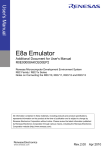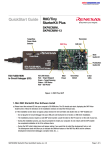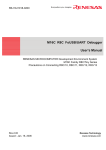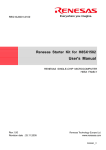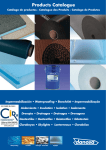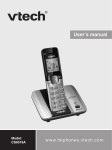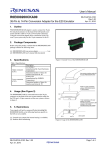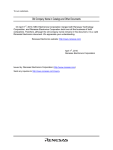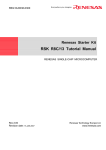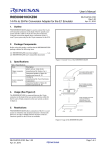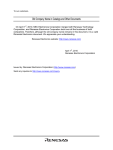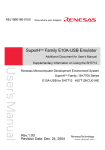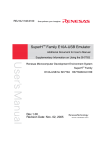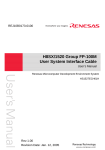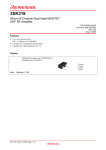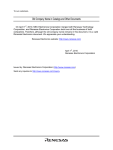Download Tiny/SLP E7 Emulator Additional Document for User`s Manual Notes
Transcript
To our customers, Old Company Name in Catalogs and Other Documents On April 1st, 2010, NEC Electronics Corporation merged with Renesas Technology Corporation, and Renesas Electronics Corporation took over all the business of both companies. Therefore, although the old company name remains in this document, it is a valid Renesas Electronics document. We appreciate your understanding. Renesas Electronics website: http://www.renesas.com April 1st, 2010 Renesas Electronics Corporation Issued by: Renesas Electronics Corporation (http://www.renesas.com) Send any inquiries to http://www.renesas.com/inquiry. Notice 1. 2. 3. 4. 5. 6. 7. All information included in this document is current as of the date this document is issued. Such information, however, is subject to change without any prior notice. Before purchasing or using any Renesas Electronics products listed herein, please confirm the latest product information with a Renesas Electronics sales office. Also, please pay regular and careful attention to additional and different information to be disclosed by Renesas Electronics such as that disclosed through our website. Renesas Electronics does not assume any liability for infringement of patents, copyrights, or other intellectual property rights of third parties by or arising from the use of Renesas Electronics products or technical information described in this document. No license, express, implied or otherwise, is granted hereby under any patents, copyrights or other intellectual property rights of Renesas Electronics or others. You should not alter, modify, copy, or otherwise misappropriate any Renesas Electronics product, whether in whole or in part. Descriptions of circuits, software and other related information in this document are provided only to illustrate the operation of semiconductor products and application examples. You are fully responsible for the incorporation of these circuits, software, and information in the design of your equipment. Renesas Electronics assumes no responsibility for any losses incurred by you or third parties arising from the use of these circuits, software, or information. When exporting the products or technology described in this document, you should comply with the applicable export control laws and regulations and follow the procedures required by such laws and regulations. You should not use Renesas Electronics products or the technology described in this document for any purpose relating to military applications or use by the military, including but not limited to the development of weapons of mass destruction. Renesas Electronics products and technology may not be used for or incorporated into any products or systems whose manufacture, use, or sale is prohibited under any applicable domestic or foreign laws or regulations. Renesas Electronics has used reasonable care in preparing the information included in this document, but Renesas Electronics does not warrant that such information is error free. Renesas Electronics assumes no liability whatsoever for any damages incurred by you resulting from errors in or omissions from the information included herein. Renesas Electronics products are classified according to the following three quality grades: “Standard”, “High Quality”, and “Specific”. The recommended applications for each Renesas Electronics product depends on the product’s quality grade, as indicated below. You must check the quality grade of each Renesas Electronics product before using it in a particular application. You may not use any Renesas Electronics product for any application categorized as “Specific” without the prior written consent of Renesas Electronics. Further, you may not use any Renesas Electronics product for any application for which it is not intended without the prior written consent of Renesas Electronics. Renesas Electronics shall not be in any way liable for any damages or losses incurred by you or third parties arising from the use of any Renesas Electronics product for an application categorized as “Specific” or for which the product is not intended where you have failed to obtain the prior written consent of Renesas Electronics. The quality grade of each Renesas Electronics product is “Standard” unless otherwise expressly specified in a Renesas Electronics data sheets or data books, etc. “Standard”: 8. 9. 10. 11. 12. Computers; office equipment; communications equipment; test and measurement equipment; audio and visual equipment; home electronic appliances; machine tools; personal electronic equipment; and industrial robots. “High Quality”: Transportation equipment (automobiles, trains, ships, etc.); traffic control systems; anti-disaster systems; anticrime systems; safety equipment; and medical equipment not specifically designed for life support. “Specific”: Aircraft; aerospace equipment; submersible repeaters; nuclear reactor control systems; medical equipment or systems for life support (e.g. artificial life support devices or systems), surgical implantations, or healthcare intervention (e.g. excision, etc.), and any other applications or purposes that pose a direct threat to human life. You should use the Renesas Electronics products described in this document within the range specified by Renesas Electronics, especially with respect to the maximum rating, operating supply voltage range, movement power voltage range, heat radiation characteristics, installation and other product characteristics. Renesas Electronics shall have no liability for malfunctions or damages arising out of the use of Renesas Electronics products beyond such specified ranges. Although Renesas Electronics endeavors to improve the quality and reliability of its products, semiconductor products have specific characteristics such as the occurrence of failure at a certain rate and malfunctions under certain use conditions. Further, Renesas Electronics products are not subject to radiation resistance design. Please be sure to implement safety measures to guard them against the possibility of physical injury, and injury or damage caused by fire in the event of the failure of a Renesas Electronics product, such as safety design for hardware and software including but not limited to redundancy, fire control and malfunction prevention, appropriate treatment for aging degradation or any other appropriate measures. Because the evaluation of microcomputer software alone is very difficult, please evaluate the safety of the final products or system manufactured by you. Please contact a Renesas Electronics sales office for details as to environmental matters such as the environmental compatibility of each Renesas Electronics product. Please use Renesas Electronics products in compliance with all applicable laws and regulations that regulate the inclusion or use of controlled substances, including without limitation, the EU RoHS Directive. Renesas Electronics assumes no liability for damages or losses occurring as a result of your noncompliance with applicable laws and regulations. This document may not be reproduced or duplicated, in any form, in whole or in part, without prior written consent of Renesas Electronics. Please contact a Renesas Electronics sales office if you have any questions regarding the information contained in this document or Renesas Electronics products, or if you have any other inquiries. (Note 1) “Renesas Electronics” as used in this document means Renesas Electronics Corporation and also includes its majorityowned subsidiaries. (Note 2) “Renesas Electronics product(s)” means any product developed or manufactured by or for Renesas Electronics. User’s Manual Tiny/SLP E7 Emulator Additional Document for User’s Manual Tiny/SLP E7 HS0007TCU01HEP4 Renesas Microcomputer Development Environment System M16C Family / R8C/Tiny Series Notes on Connecting the R8C/13, R8C/12, R8C/11, and R8C/10 Rev.3.0 2004.09 Keep safety first in your circuit designs! 1. Renesas Technology Corp. puts the maximum effort into making semiconductor products better and more reliable, but there is always the possibility that trouble may occur with them. Trouble with semiconductors may lead to personal injury, fire or property damage. Remember to give due consideration to safety when making your circuit designs, with appropriate measures such as (i) placement of substitutive, auxiliary circuits, (ii) use of nonflammable material or (iii) prevention against any malfunction or mishap. Notes regarding these materials 1. These materials are intended as a reference to assist our customers in the selection of the Renesas Technology Corp. product best suited to the customer's application; they do not convey any license under any intellectual property rights, or any other rights, belonging to Renesas Technology Corp. or a third party. 2. Renesas Technology Corp. assumes no responsibility for any damage, or infringement of any thirdparty's rights, originating in the use of any product data, diagrams, charts, programs, algorithms, or circuit application examples contained in these materials. 3. All information contained in these materials, including product data, diagrams, charts, programs and algorithms represents information on products at the time of publication of these materials, and are subject to change by Renesas Technology Corp. without notice due to product improvements or other reasons. It is therefore recommended that customers contact Renesas Technology Corp. or an authorized Renesas Technology Corp. product distributor for the latest product information before purchasing a product listed herein. The information described here may contain technical inaccuracies or typographical errors. Renesas Technology Corp. assumes no responsibility for any damage, liability, or other loss rising from these inaccuracies or errors. Please also pay attention to information published by Renesas Technology Corp. by various means, including the Renesas Technology Corp. Semiconductor home page (http://www.renesas.com). 4. When using any or all of the information contained in these materials, including product data, diagrams, charts, programs, and algorithms, please be sure to evaluate all information as a total system before making a final decision on the applicability of the information and products. Renesas Technology Corp. assumes no responsibility for any damage, liability or other loss resulting from the information contained herein. 5. Renesas Technology Corp. semiconductors are not designed or manufactured for use in a device or system that is used under circumstances in which human life is potentially at stake. Please contact Renesas Technology Corp. or an authorized Renesas Technology Corp. product distributor when considering the use of a product contained herein for any specific purposes, such as apparatus or systems for transportation, vehicular, medical, aerospace, nuclear, or undersea repeater use. 6. The prior written approval of Renesas Technology Corp. is necessary to reprint or reproduce in whole or in part these materials. 7. If these products or technologies are subject to the Japanese export control restrictions, they must be exported under a license from the Japanese government and cannot be imported into a country other than the approved destination. Any diversion or reexport contrary to the export control laws and regulations of Japan and/or the country of destination is prohibited. 8. Please contact Renesas Technology Corp. for further details on these materials or the products contained therein. Contents Section 1 Connecting the Emulator with the User System ................................1 Section 2 Pin Assignments of the E7 Connector ...............................................3 Section 3 Example of E7 Connection ................................................................5 Section 4 Differences between the MCUs and the Emulator ............................9 i ii Section 1 Connecting the Emulator with the User System Before connecting an E7 emulator (hereafter referred to as emulator) with the user system, a connector must be installed in the user system so that an user system interface cable can be connected. When designing the user system, refer to figure 2.1, Pin Assignments of the E7 Connector, and figure 3.1, Example of E7 connection, shown in this manual. Before designing the user system, be sure to read the E7 emulator user’s manual and the hardware manual for related MCUs. Table 1.1 shows the recommended connector for the emulator. Table 1.1 Recommended Connector Type Number Manufacturer Specifications 2514-6002 3M Limited 14-pin straight type Connect pins 2, 4, 6, 10, 12, and 14 of the user system connector to GND firmly on the PCB. These pins are used as electrical GND and to monitor the connection of the user system connector. Note the pin assignments of the user system connector. User system interface cable Tab Connector Pin 2 Pin 1 User system Figure 1.1 Connecting the User System Interface Cable to the User System 1 Notes: 2 1. Do not place any components within 3 mm of the connector. 2. When the emulator is used in the writer mode, connect the emulator similarly to the user system. Section 2 Pin Assignments of the E7 Connector Figure 2.1 shows the pin assignments of the connector. Pin 1 mark Pin No. Connector Pin 14 Pin 2 Pin 1 Pin 13 Pin 1 mark 1 2 3 4 5 6 7 8 9 10 11 12 13 14 Signal Name R8C/10, R8C/11 R8C/12, R8C/13 CNVss Vss N.C. Vss P00/AN7/TxD11 Vss MODE Vcc N.C. Vss P37/TxD10/RxD1 Vss RESET Vss Figure 2.1 Pin Assignments of the E7 Connector 3 4 Section 3 Example of E7 Connection Figure 3.1 shows the connecting example. Pulled-up at 33 k Vcc Vcc Vcc or more Vcc Pulled-up at 4.7 k or more Vcc MODE MODE P00 P00/TxD11 P37 P37/RxD1 CNVss CNVss R8C/13 R8C/12 R8C/11 R8C/10 Vcc User logic * RESET RESET Vss Pulled-up at 4.7 k or more Pulled-down at 4.7 k or more User system Connector 14 pins with a 2.54-mm pitch *: Open-collector buffer Figure 3.1 Example of E7 Connection In the ‘Writing Flash memory’ mode, where the user program is simply written to the flash memory, the specification of connection between the E7 and the MCU is the same as that shown in figure 3.1. 5 Notes: 1. P00 and P37 pins are used by the emulator. Pull up and connect the emulator and MCU pins. Vcc User system connector Vcc Pulled-up at 4.7 k 5 P00/TxD11 P00 11 P37/RxD1 P37 R8C/13 R8C/12 R8C/11 R8C/10 Figure 3.2 Connection of E7 Emulator and MCU 2. The E7 emulator uses the MODE pin for the MCU control and the forced break control. Connect the emulator to the MCU pins through pull-up. Vcc User system connector 7 MODE Pulled-up at 33 k or more R8C/13 R8C/12 MODE R8C/11 R8C/10 Figure 3.3 Connection of E7 Emulator and MODE Pin 3. The E7 emulator uses the CNVss pin for the MCU control and communication. Connect the emulator to the MCU pins through pull-down. User system connector CNVss 1 Pulled-up at 4.7 k or more R8C/13 R8C/12 CNVss R8C/11 R8C/10 Figure 3.4 Connection of E7 Emulator and CNVss Pin 6 4. The RESET pin is used by the emulator. Create the following circuit by connecting the open-collector output buffer so that reset input can be accepted from the emulator. Vcc User system connector User logic * 13 RESET* Pulled-up at 4.7 k R8C/13 R8C/12 RESET R8C/11 or more R8C/10 *: Open-collector buffer Figure 3.5 Example of a Reset Circuit 5. Connect Vss and Vcc with the Vss and Vcc of the MCU, respectively. 6. Connect nothing with N.C. 7. The input voltage, Vcc, must be connected to the user system Vcc (power supply). The amount of voltage permitted to input to Vcc must be within the guaranteed range of the microcomputer. 7 8. Figure 3.6 shows the interface circuit in the emulator. Use this figure as a reference when determining the pull-up resistance value. User connector Emulator control circuit Vcc 8 HD74LVC125A 10 k x2 22 22 HD74LVC244 CNVss P37 1 11 10 k x3 22 22 22 P00 MODE RESET 5 7 13 Note: The power of HD74LVC125A is supplied from Vcc in the user connector. Figure 3.6 Interface Circuit in the Emulator (Reference) 8 Section 4 Differences between the MCUs and the Emulator 1. When the emulator system is initiated, it initializes the general registers and part of the control registers as shown in table 4.1. Table 4.1 Register Initial Values at Emulator Power-On Status Register Initial Value Emulator Power-On PC Reset vector value in the vector address table R0 to R3 (bank 0, 1) 0000h A0 to A1 (bank 0, 1) 0000h FB (bank 0, 1) 0000h INTB 0000h USP 0000h ISP 05FFh SB 0000h FLG 0000h 2. Operation clock during a break During a user program break, the emulator operates with the on-chip oscillator since it is controlled without depending on the user's system clock. 3. RESET signal When debugging the R8C/Tiny, do not reset the emulator from the user target system, even in the case during user program execution or break. If the emulator is reset from the user target system, the E7 cannot be controlled. To reset the emulator, use the HEW. 4. Memory access during emulation execution If the memory contents are referenced or modified during emulation, realtime emulation cannot be performed because the user program is temporarily halted. 5. The emulator communicates with the MCUs by using the MODE, RESET , P00, P37, and CNVss pins. 6. The power consumed by the MCU can reach several mA. This is because the user power supply drives one HD74LV125A to make the communication signal level match the usersystem power-supply voltage. The power consumed rises little during user program execution since the emulator does not perform communication; it rises more during a break. 9 7. Program area for the emulator Do not access a part of areas in the flash memory since the emulator program uses these areas for 16-kB version (R5F21104, R5F21114, R5F21124, and R5F21134). If the contents of the program areas for the emulator are changed, the emulator will not operate normally. In this case, restart the emulator with the ‘Download emulator firmware’ mode. Table 4.2 Program Area for the E7 Emulator Program Area Device Vector, etc. R5F21102 R5F21122 R5F21112 R5F21132 R5F21103 R5F21123 FFE4h to FFE7h, R5F21113 R5F21133 FFE8h to FFEBh, - R5F21104 FFECh to FFEFh, R5F21114 FFF4h to FFF7h, FFF8h to FFFBh R5F21124 R5F21134 Flash Memory C000h to C7FFh 2000h to 27FFh or C000h to C7FFh* Note: The following dialog box is displayed when starting the emulator, and the location of a firmware can be selected. When the emulator is started with the ‘Does not download emulator firmware’ mode, select the area where the firmware has been written to previously. Figure 4.1 [Firmware Location] Dialog Box 8. The emulator uses a two-word stack pointer when a user program breaks. Accordingly, reserve the two-word addresses for the stack area. 9. Do not use an MCU that has been used for debugging. Also, do not save the contents of the MCU’s flash memory that have been used for debugging or use them as the ROM data for products. 10 10. Internal I/O register used by the program for the E7 emulator As the internal I/O registers below are used by the emulator program, they are not initialized by selecting [Debug] -> [Reset CPU] or with the RESET command. If their contents are referred to, a value that has been set in the emulator program will be read. Do not change the registers related with serial I/O1 because the E7 cannot be controlled. In addition, when the PD3 register is written to, set bit 7 to 0. CM0, CM1, HR0, HR1, OCD, PRCR, U1MR, U1BRG, U1C0, U1C1, UCON, U1TB, U1RB, and FLG 11. Debugging in the stop mode or wait mode When using the stop mode or wait mode on a user program, firstly disable the automatic update in the [Watch] window or fix the display in the [Memory] window so that the memory access will not occur during execution. In addition, do not operate the window until the program stops at the breakpoint by setting the breakpoint at the processing unit where the stop mode or wait mode is cancelled. 12. Debugging of a watchdog timer During firmware operation, if a memory is accessed via the firmware, realtime operation will not be performed because the watchdog timer is being refreshed. Therefore, when the watchdog timer is used on the user program, only a free run can be used. At this time, do not operate the window during execution as well as in the stop mode or wait mode. 13. Peripheral I/Os during a break During a break, although interrupts are not accepted, peripheral I/Os continue to be operated. For example, a timer interrupt is not accepted although counting a timer is continued when a user program is stopped by a break after operating a timer. 14. Exceptional step operation a) Software-interrupt instruction STEP operation cannot be performed by continuously executing the internal processing of instructions (undefined, overflow, BRK, and INT) which generates a software interrupt. <Example> NOP NOP INT NOP JMP #3 MAIN Passes through if the STEP operation is carried out. INT_3: NOP NOP NOP REIT The address at which the program should be stopped 11 b) INT instruction Debugging of the program using the INT instruction should be used with the GO command by setting a software break for the internal processing of the INT instruction. <Example> NOP INT #3 NOP JMP MAIN Execution with the GO command INT_3: NOP NOP REIT Break 15. Debugging while the R8C/Tiny is in use a) If stepping is executed on a “pushc FLG” instruction, the IPL (interrupt priority level) of FLG restored by “popc FLG” will be 0. b) If stepping is executed on an “LDC src,FLG” instruction, the I flag may not be cleared. c) If stepping is executed on an “STC FLG,dest” instruction, the content of bit 6 of the FLG register will be cleared and replaced with the content of bit 1. This value will be saved. Do not perform the following operations on the instructions mentioned above: Setting breakpoints (hardware or software breakpoints) Step-in, step-over, and step-out execution 16. Note on Go to cursor function While the R8C/Tiny is in use, the [Go to cursor] function is realized by event breaks. All event breakpoints being set are thus invalid if [Go to cursor] is executed. Note, however, that all PC breakpoints remain valid. 12 Tiny/SLP E7 Emulator Additional Document for User’s Manual Notes on Connecting the R8C/13, R8C/12,R8C/11, and R8C/10 Publication Date: Published by: Edited by: Rev.1.00, August 25, 2003 Rev.3.00, September 13,2004 Sales Strategic Planning Div. Renesas Technology Corp. R8C-Tiny Group Renesas Solutuions Corp. ©2004. Renesas Technology Corp., All rights reserved. Printed in Japan. Sales Strategic Planning Div. Nippon Bldg., 2-6-2, Ohte-machi, Chiyoda-ku, Tokyo 100-0004, Japan RENESAS SALES OFFICES http://www.renesas.com Refer to "http://www.renesas.com/en/network" for the latest and detailed information. Renesas Technology America, Inc. 450 Holger Way, San Jose, CA 95134-1368, U.S.A Tel: <1> (408) 382-7500, Fax: <1> (408) 382-7501 Renesas Technology Europe Limited Dukes Meadow, Millboard Road, Bourne End, Buckinghamshire, SL8 5FH, U.K. Tel: <44> (1628) 585-100, Fax: <44> (1628) 585-900 Renesas Technology Hong Kong Ltd. 7th Floor, North Tower, World Finance Centre, Harbour City, 1 Canton Road, Tsimshatsui, Kowloon, Hong Kong Tel: <852> 2265-6688, Fax: <852> 2730-6071 Renesas Technology Taiwan Co., Ltd. 10th Floor, No.99, Fushing North Road, Taipei, Taiwan Tel: <886> (2) 2715-2888, Fax: <886> (2) 2713-2999 Renesas Technology (Shanghai) Co., Ltd. Unit2607 Ruijing Building, No.205 Maoming Road (S), Shanghai 200020, China Tel: <86> (21) 6472-1001, Fax: <86> (21) 6415-2952 Renesas Technology Singapore Pte. Ltd. 1 Harbour Front Avenue, #06-10, Keppel Bay Tower, Singapore 098632 Tel: <65> 6213-0200, Fax: <65> 6278-8001 Colophon 2.0 Tiny/SLP E7 Emulator Additional Document for User’s Manual Tiny/SLP E7 HS0007TCU01HEP4 1753, Shimonumabe, Nakahara-ku, Kawasaki-shi, Kanagawa 211-8668 Japan REJ10B0046-0300H























